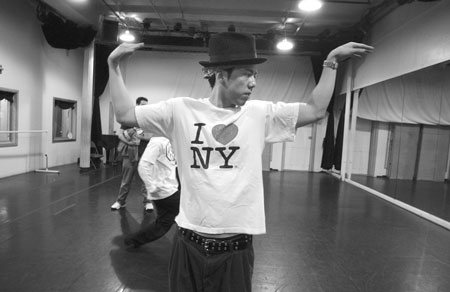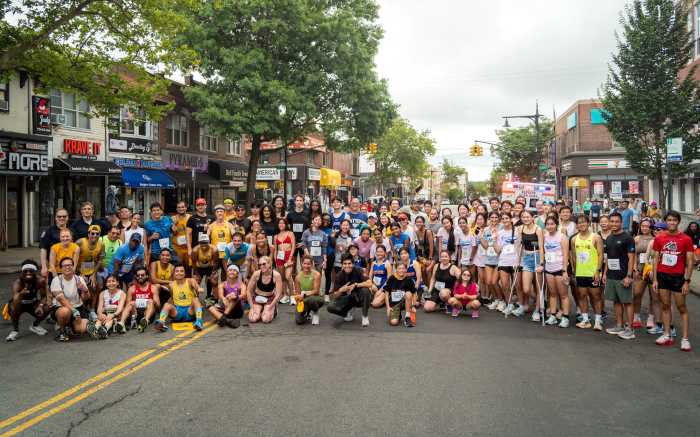By Atticus Brady
During the week, Chris Lim wakes up in his apartment on the Lower East Side, takes a train to Stamford, Connecticut, and goes to work at Factset Research Systems where he has been a software programmer since graduating from college two years ago.
His weekends are a whole other story.
On Saturdays at 6 p.m. Lim can be found in one of the spacious, mirrored studios at the Dance Space Center in Soho near Chinatown, stretching to the beat of classic funk songs, preparing for a rigorous two-hour practice session. He wears a white bandanna around his head, a red shirt with silver graffiti writing, grey cargo pants and red shoes. During these two hours, he is not really Chris Lim at all. Unless you are a close friend of a friend, he will only introduce himself as Dementia.
Lim’s alter ego is a gifted practitioner of the dance style known as popping, a unique variation of mime that has its roots in West Coast urban street dancing of the 1960s and ‘70s. Although the 24-year-old Lim describes popping as a hobby, he has turned it into something of a side-career, appearing last summer in Missy Elliot’s video of “Cop That Disc,” performing in the Hip Hop Theater Festival, and attending popping events and contests.
After stretching, Dementia extends his right arm straight out in front of him. There is a quick flexing of the muscle, resulting in a lightning-fast twitch. He repeats the action with his left arm, then alternates between the two until it is time to practice body waves. First the fingers curl, followed by the knuckles, the wrist collapses, followed by the elbow, then the shoulder. From there the wave travels through his chest down to his legs which swivel and kick the wave back to where it came from. Sometimes the moves are executed in a robotic, staccato fashion. Other times they are more fluid, or as Dementia puts it, “more like water.”
These exercises, intricate and graceful as they are, are only the prelude to a medley of seemingly impossible movements wherein arms, hips, legs, and feet swirl and pivot in what looks like opposite directions, giving the impression of limbs disconnecting and reconnecting, often in the same moment.
“It’s the illusional part of popping that I like,” said Dementia. “Separating body parts, doing things that don’t seem possible.”
The emphasis in popping, he says, is on spontaneity. Most filmed dance sequences involving tap, jazz, or ballet often require many hours of choreography and rehearsal, but nearly all of the footage that has ever captured a popping event or routine has captured it raw, created entirely off-the-cuff. Dementia himself never knows what he is going to do before he does it: “I do not have a set of combinations I execute every time. There are moves and small combinations that I use more than once, but never an entire set of memorized moves. A lot of the stuff I do is spur of the moment.”
Popping had modest beginnings as an underground art form in the ‘70s, but exploded in the early ‘80s when Hip Hop and all its attendant subgenres like graffiti art and DJing started to shift popular culture in a new direction. Since then, popping has frequently been either confused with or referred to in the mainstream media as breakdancing, where moves such as windmills and headspins are executed close to the ground. This misconception was compounded by the release of a successful 1984 film called “Breakin’.” The movie, according to Dementia, contains mostly popping.
“I can watch popping for a long time, but I get kind of bored watching breaking,” he said. “In popping there’s more of a focus on dance ability and skill. It’s less about acrobatics and strength. The dancing aspect of it is what got to me.”
Lim, who is Chinese, was still a child when popping came into vogue. He grew up in Scarsdale, the son of a dermatologist and an internist, and briefly considered going pre-med until a chemistry course made him realize that medicine was not in his future. As a high school senior he went to his first rave where he was introduced to a dance style called “liquid” whose staple move is a sinuous, wave-like motion of the arms.
Lim majored in computer engineering at the University of Michigan, but continued going to raves, eventually making the transition from liquid to popping. He imitated the moves he saw on instructional videos by dancers with names like Mr. Wiggles and Poppin’ Pete, legends within the culture. He picked the moves up quickly.
“It’s 50 percent taught, 50 percent natural ability,” he said. “The natural ability will determine how fast you learn. Some people study for years and years, but learn slowly. Some people watch videos for a year and get great at it.’
Lim moved to Manhattan after getting his B.A., and remembers sitting around with a group of dancer friends who asked whether he had a “popping name.”
“I said no. And they started saying ‘How about Dimension? Or Tetris? Or Cube?’ And then someone said Dementia, and that sounded good. So my friends gave me the name. And they told me I had to live up to it.”
In addition to performing, competing, and holding outdoor summer practice sessions in Union Square, Dementia runs the New York Popshop at the Dance Space Center at 451 Broadway. The Popshop gives dancers a chance to get together twice a week to refine their skills and feed off one another. Despite its bias toward poppers, breakdancers are also welcome.
Reader Services


























